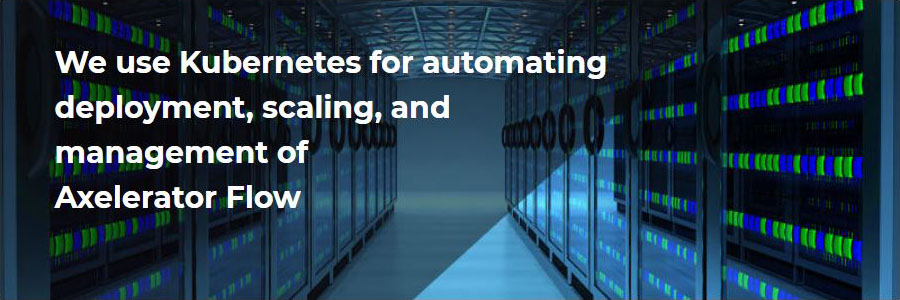Axelerator Flow is released Full end-to-end SaaS solution for Insurance

SaaS Axelerator Flow for Life Insurance released July 2022
Axelerator, like almost every Internet based software, is built on open-source and proprietary software components and deployed on current cloud technology platforms.
For security reasons it is critical that we continue to update Axelerator to use the latest proven technology. Current technology also makes available a host of other improvements including responsiveness, resilience, capacity, scalability and performance.
And with better technology we can be more productive in adding functionality and features to Axelerator and in rolling out new releases to our clients.
As a result of these changes we no longer support clients managing their own hosting environments or allowing them to select their preferred server and web technology.
A key change in the new architecture is that instead of the system being deployed in a single Virtual Machine (VM) we now deploy Axelerator in multiple containers in the Amazon AWS and Google GCP Cloud environments. We have also updated Axelerator to work closely with the AWS and GCP cloud platform.
Therefore from release V22.1 on – released in July 2022, Axelerator is only available as a full Software-As-A-Service cloud solution managed by Axe.
Key changes in the SaaS version – Axelerator Flow
1. Functionality
Our R&D team has been busy, not only with moving Axelerator to a cloud native application, but also adding in a vast amount of new functionality and capability. Axelerator Flow is now a full end-to-end solution across policy, claims, reinsurance and back office processing.
Contact our sales team for more information and a demonstration.

2. Expanded EcoSystem
Axelerator Flow comes with a large EcoSystem of third party tools and cloud services. For example payment gateways, identity management, document generation and distribution, medical report processing, injury assessment, call centre integration, online chat, data ETL tools, data lake, and address validation.
We are constantly adding to this list. The EcoSystem lets our clients switch on the third party tools as needed, with no need to build custom integration or arrange contracts with the third parties.

3. Microservices
In any construction project specialization and being able to use the right tools is critical. You don’t expect a plumber to wire your house or a carpenter to bang screws in with a hammer.
Microservices architecture involves separating an application into smaller modules that can be developed, tested and deployed on their own. Each microservice team can select the most suitable technologies, technical stack and assign appropriate system resources for the microservice.
They provide a number of major benefits:
- Performance - each micro-service is individually configured to have the ideal settings for its performance
- Scalability - when overloaded a microservice will automatically spawn new containers to spread the load
- Security - APIs can be opened only for a specific microservice and not allow access the API user to access the full system or database
- Development velocity - development can be scaled faster by having separate teams working on each micro-service
- Faster release cycles - microservices can be deployed on their own, avoiding the need for a full system deployment for each change
4. Cloud Native
To get the full benefit of microservices also means going to serverless containers.
Containers replace the use of Virtual Machines (VMs) for applications. They are light weight environments that use the operating system from the platform rather than having their own included in the VM.
They are dedicated to the service they provide, and therefore are set up with resources allocated to suit the processes they perform.

5. Container Orchestration
We use Kubernetes for automating deployment, scaling, and management of Axelerator Flow.
It groups the containers that make up the application into logical units for easy management and discovery. Kubernetes builds upon 15 years of experience of running production workloads at Google, combined with best-of-breed ideas and practices from the community.
Using Kubernetes allows us to seamlessly manage the relatively complex Cloud environment of Axelerator Flow and tp deliver deployments rapidly and consistently across all the test and production environments.

6. Single Page
Previously Axelerator, like most web applications, would deal with a web page as a single entity, so when, for example “next” is clicked on a web page, the browser sends all the page data back to the server to process. The server would then send back an entire replacement page. The web page momentarily disappears and the updated page is displayed.
We are now halfway through a major exercise to migrate all the elements that make up the forms and dashboards in Axelerator Flow to ‘single page’ JavaScript based components so as a user changes data on a page, the changes are seamlessly sent back to the server, and only the changed elements on the page are updated.
This is often referred to as “snappy”. It is similar to what is now taken for granted in Phone applications.

7. Data handling
Generally web systems manage data files by storing them in an SQL database and retrieving them on demand. This can be very slow when large data files are being handled, for example when uploading and storing large files or when generating large PDF files for viewing, printing and saving.
We’ve built a microservice using some AWS and GCP specific services and third party tools to rapidly speed up the handling of large files, especially PDF generation.
